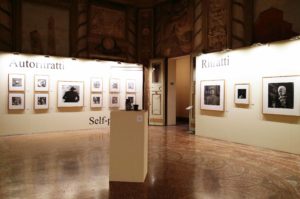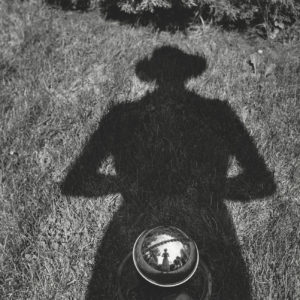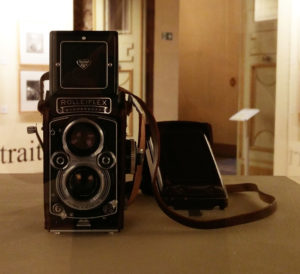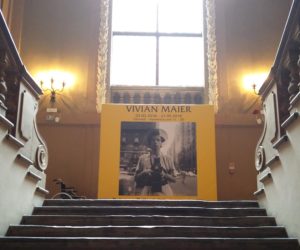Palazzo Pallavicini, Bologna, Italy
www.palazzopallavicini.com
3 March – 27 May 2018
The Palazzo Pallavicini just opened an exhibition dedicated to Vivian Maier (1926-2009). This American photographer is for several reasons exceptional. First of all, her official profession was not photographer, but nanny. This autodidact shot over 120.000 photos. None of them was ever published during her lifetime and she even didn’t show them to anyone. Probably some people saw them, for example the ones who made the prints for her in the drugstore. She had only a short period were she had the possibility, to develop them herself.
 Besides this peculiarity, the biggest part of the negatives were never developed at all. In consequence, it is unknown, if and how she envisaged the pictures. The 120 images in the exhibition are the choice of Vivian Maier’s discoverer, John Maloof. Nevertheless, the photos on view are interesting as documentary of street life in American metropoles. However, more stimulating is the artistic view. Therefore, we will first take a look at the exhibition, which is portioned in six chapters. Later we will take a glance at Vivian Maier’s biography.
Besides this peculiarity, the biggest part of the negatives were never developed at all. In consequence, it is unknown, if and how she envisaged the pictures. The 120 images in the exhibition are the choice of Vivian Maier’s discoverer, John Maloof. Nevertheless, the photos on view are interesting as documentary of street life in American metropoles. However, more stimulating is the artistic view. Therefore, we will first take a look at the exhibition, which is portioned in six chapters. Later we will take a glance at Vivian Maier’s biography.
Street Life
In the section “Street Life” the images are depicting scenes at the street, the architecture itself or both. At this, the buildings and streets apparently function as urban backdrop. There is a nun, sitting in an entrance. Through the doorway, the passing cars are visible. A man is looking from a roof onto a street; a woman is discussion with a policeman; a man is sitting on a chair in front of shop. These are ordinary scenes of daily urban life. The people are coming from all social levels. Some seem to be solitary among the huge constructions; others seem to be strolling relaxed. There are single persons or groups. Rarely, there is a direct contact to the photographer. On the contrary, the image section is chosen from a distant point. Vivian Maier depicted strangers, unnamed people and shows the whole spectrum of a metropolitan city. She observes intensively, to press the shutter release in the right moment. In doing so, she sometimes catches amusing moments and experiments with formal almost abstract elements.
Forms
Correspondingly, another chapter is called “Forms”. The focus here is on structures, forms and geometries. In the contrary to the street life scenes, the object appears less essential, although partly there are as well people depicted. Nevertheless, the framing and the balance of the image is important. This could be the look into a crown of a tree, stacked wooden boxes or men reading newspaper in a train.
Childhood
In the section “Childhood”, the human being is once again the point of attention. There are severe or even sad looking children. Some are depicted from a distant position like in “Street Life”; others are posing for the photographer. The kids are shown in relations to adults or alone. They are playing or discovering their environment. Due to her work as nanny, it seems that Vivian Maier had a special interest for children and sometimes she even captures the ones intrusted to her.
Portraits
A particular form of street photography are the portraits. The urban space moves into the background and the individual person comes into focus, even though the distance is kept. Therefore, her preferred perspective is the medium long shot. In the selection on view, the social classification is accentuated by compositional arrangement: seemingly upper class people are mostly taken from below; some – especially children ore young adults – are at eye level and social outsiders are taken from above.
Self-Portraits
Vivian Maier had a special predilection for self-portraits. Often they seem as a surprising encounter with herself, since they are reflexions in windows, mirrors or shadows. Hence, her image is distorted or blurry. Nonetheless, these self-presentations are probably not as incidental as they appear. One of the rare in-room photos shows the photographer besides a camera mounted on a tripod looking into a mirror.
Colours
In 1965, Vivian Maier started with colour photography. Most of the 20 presented images are dating from the 1970s and are made from colour transparencies. Soon afterwards – in the beginning of the 1980s – she stopped completely to use her Rolleiflex with black-and-white films, but for a while, she worked with both. This change of the camera, not only affected the nature of the outcome, but also the practice of photographing. With the Rolleiflex, the photographer holds the camera in front of the belly and looks from the top onto the image. This allows relatively discreet shots. With the Leica and later the Kodak Ektachrome, the camera is on eye level. This modifies the perspective to the targeted object. Unfortunately, the films of Vivian Maier’s colour photos are less well conserved, so that currently only few are accessible to the public.
The colour photos in the exhibition reveal that the photographer added the effects of colour to her artistic language. She points on flashing vibrant hues. Therefore, the images partly give the impression of a black and white picture accented by colour retouching. Whereas others show compositions, based on different hues. Often, there is an interrelation between colours and form.
Vivian Maier
 Born in 1926 in New York, Vivian Maier was the second child of an immigrant family. Her father descended from an Austrian noble family and the mother originated from France. When the photographer was four years old, the parents separated. Soon afterwards, mother and child were registered at the address of the French sculptor and portrait-photographer Jeanne Bertrand. Two years later, in 1932, the mother went back to France, where she stayed with her daughter until 1938. Then they returned to the United States.
Born in 1926 in New York, Vivian Maier was the second child of an immigrant family. Her father descended from an Austrian noble family and the mother originated from France. When the photographer was four years old, the parents separated. Soon afterwards, mother and child were registered at the address of the French sculptor and portrait-photographer Jeanne Bertrand. Two years later, in 1932, the mother went back to France, where she stayed with her daughter until 1938. Then they returned to the United States.
At the age of 24/25, Vivian Maier came back to France to sell an inherited family property. During this time, she made her first preserved photos from the landscape and family members. Back in New York, she bought her first professional camera – a Rolleiflex. Supported by funds received from her heritage, she travelled North America. Subsequently she worked in a household in Southampton until she settled in 1956 in Chicago, where she worked as nanny at the Gensburg family for 17 years. In 1959/60, she took an extended holiday of six months. During this time, she travelled alone to Thailand, India, Yemen, Egypt, Italy and France and made many photos. At the house of the Gensburgs she had a separated bathroom, where she could develop her shots on her own. When the Gensburg children became adult, Vivian Maier continued to work as nanny in other households, but left the making of prints to drugstores. It seems that she stopped photographing in the mid-1980s.
Many of her negatives stayed undeveloped. In consequence, Vivian Maier never saw thousands of her photos herself. Presumably, she became homeless at the end of the 1990s and the beginning new millennium or lived in very poor conditions. Her boxes with negatives, prints, audio recordings and 8mm films went into a storage space. Fortunately, the Gensburg brothers looked after her former nanny, provided her with an apartment and payed her bills. In November 2008, Vivian Maier fell on ice and hit her head. After her stay in hospital, she lived in a nursing house and died on April 21, 2009.
 Regarding the few sources, the impressive photographer led a solitary life. Besides the exception of the Gensburg family – where she worked for seventeen years – she restrained the private relation to her employers to the minimum. Beyond that, she didn’t seem to have had friends or intensive contact to her family. At the same time, she collected – besides her photos and negatives – all sorts of objects, like tickets, receipts and particularly newspapers. On the other hand, she took interest in public life, like the Vietnam War and the Watergate Scandal and questioned people about their opinion. Her audio recordings and 8mm films bear witness of that. Not least her photographic oeuvre shows a critical view on society, since she had a special sight on a socially excluded population. Moreover, the pictures indicate, that the photographer had knowledge about other artists and their experience.
Regarding the few sources, the impressive photographer led a solitary life. Besides the exception of the Gensburg family – where she worked for seventeen years – she restrained the private relation to her employers to the minimum. Beyond that, she didn’t seem to have had friends or intensive contact to her family. At the same time, she collected – besides her photos and negatives – all sorts of objects, like tickets, receipts and particularly newspapers. On the other hand, she took interest in public life, like the Vietnam War and the Watergate Scandal and questioned people about their opinion. Her audio recordings and 8mm films bear witness of that. Not least her photographic oeuvre shows a critical view on society, since she had a special sight on a socially excluded population. Moreover, the pictures indicate, that the photographer had knowledge about other artists and their experience.
Despite her secluded life, fortunately her enormous portfolio remained for the posterity, intentionally or not. The paid attention to the oeuvre via photobooks, films and exhibitions, probably led Anne Morin – the curator of the present exhibition – be delighted that Vivian Maier has a beautiful life after her death.
Discovery and recognition
In 2007, the deposited boxes with prints, negatives, recordings and private objects, came into a compulsory auction, because the rental for the storage space was not paid. Ron Slattery, Jeffrey Goldstein and John Maloof purchased these cartons, whereby the latter obtained the bigger part. After the first unsuccessful attempts to attract attention via the publication of some photo in the internet, Maloof investigated about the author. Unfortunately, no direct contact could be established, due to Vivian Maier’s bad health condition.
Nevertheless, Maloof founded the Maloof Collection to promote and safeguard the oeuvre. Until today, he published four photobooks, directed with Charlie Siskel the successful film “Finding Vivian Maier” and offers limited editions of the pictures, currently in cooperation with the Howard Greendberg Gallery, New York. Furthermore, he initiates exhibitions with other partners. The present show by DiChroma Photography, travelled before to Spain, France, Sweden, Netherlands, Germany and Italy.
Catalogue
Title: Vivian Maier: Street Photographer
Size: 10.125 x 11.125 inches
Number of pages: 136 pages
Number of ilustrations: over 100
Publisher: Powerhouse Books
ISBN: 978-1-57687-577-3







































